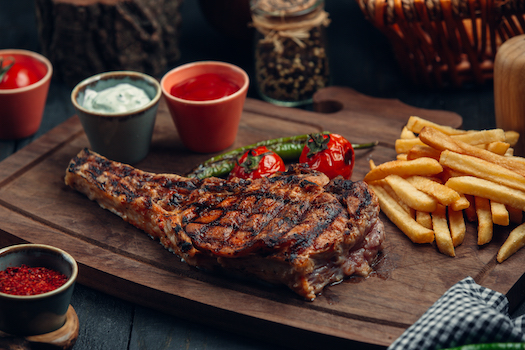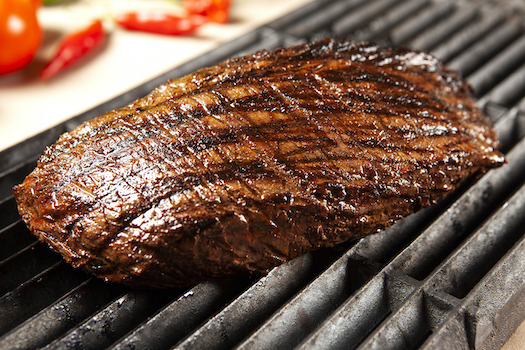When you’re standing in front of that glorious meat aisle contemplating the array of beef before you, the names “Ribeye” and “Delmonico” can be downright intimidating. Each cut promises a delectable experience, but knowing the differences can help you choose the best one for your taste and budget. In this article, we will discuss about difference between Ribeye and Delmonico Steaks.
| Ribeye Steak | Delmonico Steak |
|---|---|
 |  |
Origins and Naming of Ribeye And Delmonico Steaks
- Ribeye Steak: As the name suggests, ribeye steak is derived from the rib section of the cow, typically between the 6th and 12th ribs. This cut is known for its rich marbling and exceptional tenderness. The central “eye” of lean meat is surrounded by a well-marbled periphery, creating a balance of tenderness and flavor. Ribeye can come in boneless or bone-in variations, where bone-in versions often include a section of rib bone, adding to the flavor profile.
- Delmonico Steak: The Delmonico steak is a term steeped in history, originating from Delmonico’s, a famous restaurant in New York City, which opened in 1837. Historically, Delmonico steak referred to the choicest cut of beef served at the restaurant. Today, it can refer to various cuts, including boneless ribeye, bone-in rib steak, and boneless top loin steak, among others. The term often denotes a high-quality, thick-cut steak regardless of the specific cut.
Cut Location
- Ribeye: Cut from the rib section, specifically the upper rib cage, this steak is known for its rich marbling and tender profile due to the muscles in this area not being overly exercised. This makes the ribeye incredibly juicy and flavorful.
- Delmonico: Typically, a boneless cut, Delmonico steaks can be from various parts of the cow, including the rib section, chuck eye, or short loin. This cut is thicker and can be boneless or bone-in, depending on regional variations and specific preparation methods.
Flavor and Texture
- Ribeye: Known for its soft, buttery texture, ribeye steaks are prized for their abundant marbling, which melts during cooking, imparting a rich, beefy flavor. The bone-in variety is particularly popular as it enhances the flavor while cooking.
- Delmonico: Delmonico steaks, while still flavorful, tend to have less marbling compared to ribeyes. This results in a beefier and heavier taste, making them a more filling steak. The texture is robust, and they can be very tender when cooked properly, though not as uniformly tender as ribeyes.
Cooking Methods of Ribeye And Delmonico Steaks
- Ribeye: Versatile and forgiving, ribeyes can be cooked using various methods including grilling, pan-searing, and broiling. Their high-fat content allows them to remain juicy and flavorful even with high-heat cooking.
- Delmonico: Also versatile, Delmonico steaks can be grilled, broiled, reverse-seared, or cooked in a cast-iron skillet. Due to their thickness, they may require longer cooking times and careful monitoring to avoid overcooking. They are often marinated to enhance tenderness and flavor.
Cost and Availability
- Ribeye: Generally, more expensive due to their superior tenderness and marbling, ribeyes are a popular choice in steakhouses and are widely available in supermarkets and butcher shops.
- Delmonico: Typically, more affordable, Delmonico steaks offer a budget-friendly alternative while still delivering robust flavor. They may vary in price depending on the specific cut and source but are generally less expensive than ribeyes.
Nutritional Information about Ribeye And Delmonico Steaks
Both ribeye and Delmonico steaks are high in protein and rich in essential vitamins and minerals such as B12, zinc, and iron. However, ribeye steaks tend to have higher fat content due to their marbling, which contributes to their rich flavor but also increases calorie count and saturated fat.
Final Verdict
Choosing between ribeye and Delmonico steaks ultimately depends on personal preference and budget. Ribeye steaks are renowned for their exceptional tenderness, rich marbling, and buttery flavor, making them a favorite among steak lovers. Delmonico steaks, on the other hand, offer a robust beefy flavor and a more affordable option, though they might not match the ribeye’s tenderness. Whichever you choose, both cuts offer a delightful dining experience that showcases the quality and flavor of beef. Happy grilling!





